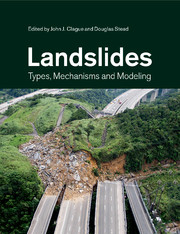Book contents
- Landslides
- Landslides
- Copyright page
- Contents
- Contributors
- Preface
- 1 Landslide hazard and risk
- 2 Landslides in the Earth system
- 3 Earthquake ground motion and patterns of seismically induced landsliding
- 4 Landslides at stratovolcanoes initiated by volcanic unrest
- 5 Mobility of long-runout rock avalanches
- 6 Rapid rock-slope failures
- 7 Risk assessments for debris flows
- 8 Landslides in quick clay
- 9 Controls on the distribution of major types of submarine landslides
- 10 Tsunami hazard assessment related to slope failures in coastal waters
- 11 Physical impacts of climate change on landslide occurrence and related adaptation
- 12 Landslides and geologic environments
- 13 Numerical modeling of rock-slope instability
- 14 Remote sensing techniques and landslides
- 15 Engineering geomorphology of landslides
- 16 Developments in landslide runout prediction
- 17 Models of the triggering of landslides during earthquakes
- 18 Slow rock-slope deformation
- 19 Landslide monitoring:
- 20 Groundwater in slopes
- 21 Soil slope stabilization
- 22 Rockfall characterization and modeling
- 23 The 2006 Eiger rockslide, European Alps
- 24 Randa:
- 25 Characterization and management of rockslide hazard at Turtle Mountain, Alberta, Canada
- 26 The Åknes rockslide, Norway
- 27 A seismometric approach for back-analyzing an unusual rockfall in the Apennines of Italy
- 28 Downie Slide, British Columbia, Canada
- 29 The 1963 Vaiont landslide, Italy
- 30 Hong Kong landslides
- 31 Landslides induced by the Wenchuan earthquake
- 32 Landslides on other planets
- Index
16 - Developments in landslide runout prediction
Published online by Cambridge University Press: 05 May 2013
- Landslides
- Landslides
- Copyright page
- Contents
- Contributors
- Preface
- 1 Landslide hazard and risk
- 2 Landslides in the Earth system
- 3 Earthquake ground motion and patterns of seismically induced landsliding
- 4 Landslides at stratovolcanoes initiated by volcanic unrest
- 5 Mobility of long-runout rock avalanches
- 6 Rapid rock-slope failures
- 7 Risk assessments for debris flows
- 8 Landslides in quick clay
- 9 Controls on the distribution of major types of submarine landslides
- 10 Tsunami hazard assessment related to slope failures in coastal waters
- 11 Physical impacts of climate change on landslide occurrence and related adaptation
- 12 Landslides and geologic environments
- 13 Numerical modeling of rock-slope instability
- 14 Remote sensing techniques and landslides
- 15 Engineering geomorphology of landslides
- 16 Developments in landslide runout prediction
- 17 Models of the triggering of landslides during earthquakes
- 18 Slow rock-slope deformation
- 19 Landslide monitoring:
- 20 Groundwater in slopes
- 21 Soil slope stabilization
- 22 Rockfall characterization and modeling
- 23 The 2006 Eiger rockslide, European Alps
- 24 Randa:
- 25 Characterization and management of rockslide hazard at Turtle Mountain, Alberta, Canada
- 26 The Åknes rockslide, Norway
- 27 A seismometric approach for back-analyzing an unusual rockfall in the Apennines of Italy
- 28 Downie Slide, British Columbia, Canada
- 29 The 1963 Vaiont landslide, Italy
- 30 Hong Kong landslides
- 31 Landslides induced by the Wenchuan earthquake
- 32 Landslides on other planets
- Index
Summary
Runout analysis is a key component of landslide risk assessment and management, and a range of empirical and numerical methods for analyzing runout are available. Significant advances have been made in the development of numerical runout models over the past decade, particularly with respect to three-dimensional modeling capabilities. As demonstrated in a recent model benchmarking workshop, most modern numerical models are able to simulate the bulk characteristics of typical real landslides. On the other hand, progress has been slower in developing suitable methodologies for selecting input parameter values for prediction. Ideally, these methods should fit within the probabilistic framework of quantitative landslide risk assessment, allowing users to estimate the spatial probability of impact and associated hazard intensity throughout the runout zone. Recent work on advanced model calibration techniques has attempted to address this need. Simple probabilistic empirical–statistical techniques can be extended to numerical modeling applications and provide a useful reference point for these discussions.
- Type
- Chapter
- Information
- LandslidesTypes, Mechanisms and Modeling, pp. 187 - 195Publisher: Cambridge University PressPrint publication year: 2012
- 5
- Cited by



